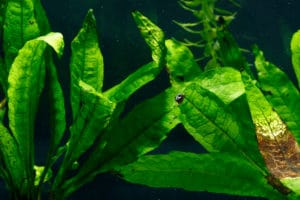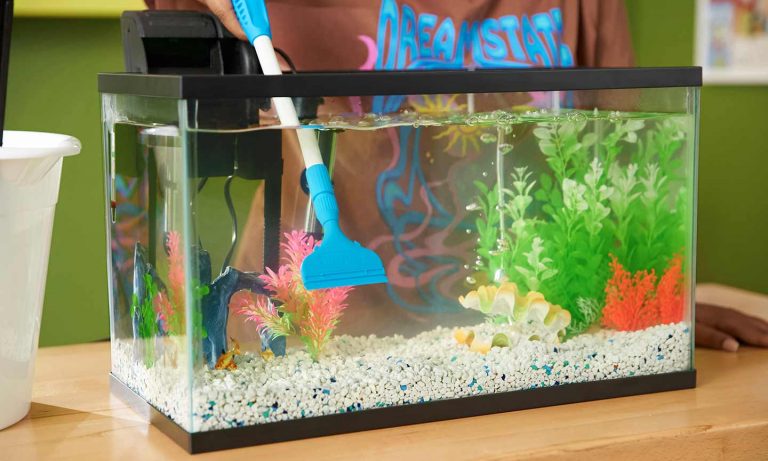This month in the Aquabotanist, we will continue our discussion about aquarium keeping during a drought by introducing the Paludarium. A paludarium is a semi-aquatic habitat replicating a wetland, rainforest or stream. Paludariums are ideal for keeping aquatic and semi-aquatic plants and amphibians. They allow the hobbyist a unique opportunity to grow a diverse collection of plants ranging from true aquatics such as Annubias to terrestrial bromeliads. Paludariums are stunningly beautiful and easy to maintain. The paludariums I keep generate the most interest of visitors to my fish room.
Converting a fish aquarium to a paludarium is not difficult with careful planning. One huge benefit to keeping a paludarium is a noticeable decrease in water since the aquarium is only partially filled with water. The depth of water depends upon the species of plants and the type of animals desired to be kept.
Planning is the key to success regardless if you are converting an established aquarium or starting new. Although starting with a new set-up is easier, a complete disassembly of your existing tank is not absolutely necessary.
Begin by making a written list of the plants and animals you want to keep. Research their needs for lighting, temperature and humidity. Consider the full grown size of the plants and animals to ensure they don’t quickly outgrow your habitat. Some bromeliads such as the small Neoregelia ‘Chiquita linda’ only grows about four inches tall while the Ananas comosus (pineapple) can grow five-feet tall. Always check the binomial (scientific name) name and do research on any plant you desire to prevent unpleasant surprises.
The Tank
Virtually any aquarium will suffice but tall tanks are especially well suited for paludariums. Height offers more flexibility in plant selection and allows the option for keeping taller growing plants. But a very beautiful paludarium can be created with a basic ten-gallon aquarium.
Equipment
The only pieces of equipment that will not work in a paludarium are hang-on-the-back filter (HOB’s) and non-submersible heaters. HOB filters require a nearly full aquarium to properly function and for safety reasons, only heaters capable of getting completely wet should be used. If a new filter is needed consider a canister filtration system. Canister filters are the most flexible with the filter completely external to the tank resting on the floor and they can be outfitted with an external, in-line heater. A second filter (if needed) can be installed inside the tank. Choose either a small, submersible power filter or power head fitted with a sponge filter. I use sponge filtration as a second filter in all of my aquariums and they are fantastic. As mentioned, an in-line heater connected to the return hose of a canister filter is the easiest, least obtrusive method of heating a paludarium. Another heater that works well (but takes tank space) is a submersible heater with a plastic heater guard. Only use heaters with plastic guards if you intend to keep any amphibians or mudskippers. Those animals enjoy resting on heaters and can easily become burned unless the heating element is shielded by a guard.
Consider the lighting needs of the plants you are desiring to keep. Unless you want to spend money for high-intensity lighting, pick plants that will thrive with your existing lighting system. Many plants are very happy with virtually any lighting system. For example, plants that can live in marsh conditions such as Dracaena and the Peace lily (Spathiphyllum wallisii) can grow in almost any light. I keep them in both bright and dim conditions and they do fine.
Making the Paludarium
Creating the land areas for your paludarim can be accomplished by using a barrier made of thin Plexiglas carefully wedged between the front and rear glass of your tank. This method allows the creation of land without completely dissembling an established aquarium. Creating the land area is easy. Move the substrate and any living plants away from the area you wish to make into land. Install the plastic barrier and then push your existing substrate up against the plastic barrier. Use rinsed, new substrate to fill the area behind the barrier.
Some paludariums have a combination of land and logs to create areas for plants and animals to grow and climb on. Use your imagination. Just be sure to only use aquarium safe rocks and wood.
Here is a list of non-aquatic (they cannot live submerged for extended periods) plants ideally suited for a paludarium. Check the care requirements prior to obtaining these plants:
- Dracaena
- Spider Plant (Chlorophytum comosum)
- Red Mangrove (Rhizophora mangle)
- African violet (Saintpaulia)
- Tillandsia
The paludariums are real conversation creators. Besides using little water, they are easy to maintain and provide a tremendous amount of enjoyment for a small level of effort. Enjoy your fish!
By: Stephen G. Noble
Feature Image: Stephen G. Noble
Share:









